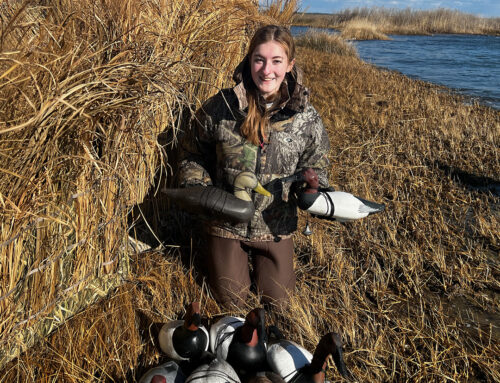How to Sneak a Duck Mount Past Your Spouse
 Kyle Wintersteen, Managing Editor
Kyle Wintersteen, Managing Editor
I have this friend. Let’s call him “Rick”. He’s as passionate a duck hunter as you’ll find, having gunned waterfowl across the United States and filled two lanyards full of bands. His home décor includes original P.S. Olt duck calls, hand-carved decoys from the Eastern Shore and the finest oil works of Maass and Redlin. But the house is lacking in one conspicuous regard: There’s nary a duck mount to be found.
Why would Rick—a serious ’fowler—not mount any birds? It’s not for lack of desire, he’s explained, but to avoid marital strife. His wife dislikes taxidermy. Hates it, even, convinced it would somehow clash with her Victorian tapestries. And given her existing consternation regarding Rick’s prolonged, duck-induced absences, he felt it was a battle best left unwaged. Still, his hope has persisted, as evidenced by the fully feathered Brewer’s duck (mallard/gadwall hybrid) and drake cinnamon teal preserved in his freezer.
I knew my friend needed help, so last season we hatched a plan. Based on our experience, here are three steps to hanging a duck mount within the home of an unwitting spouse.
Build a Duck Cave
One of Rick’s critical errors was failing to select a single location for his duck mounts and waterfowling wares. In an ideal world, we all know that every room in every home would be duck-themed to some degree. (Is the kitchen not a perfect place to display a spoonbill’s utensil-like mandible?) However, when a spouse disdains taxidermy, compromise is in order: Rick needed a man cave. Known as “dens” before Woman convinced Man to forfeit the run of the house, they’re ideal locations for duck mounts.
Rick decided his finished basement would be perfect. The next step was to stage the area in a manner in which duck mounts would appear a fitting choice to even the most unrelenting of spouses. So, to his wife’s delight, Rick moved his duck paraphernalia from the living quarters to the cave. From the canvasback-adorned pilsner glasses to the miniature punt-gun replica, he created a duck hunter’s paradise—but for one feathered omission.
Lay on the Guilt
Now it was my time to shine. With Rick’s wife at his side, he proudly gave me a grand tour of the cave. We sampled its amber beverages, examined decoys by Jobes and Vincenti, and all the while anticipated my pre-orchestrated speech.
“It’s great, Rick, really great,” I said, pausing for dramatic effect. “But if you want my honest opinion, this space really cries out for taxidermy. Don’t you have a Brewer’s duck and a cinnamon in the freezer? Those are birds of a lifetime.”
Rick stared into his drink. His wife looked on sympathetically.
“Well, I don’t know,” he replied. “What do you think, honey?”
Treat the Expense with Care
We’d set a trap, executed it perfectly, and Rick’s ducks were delivered to the taxidermist the following week. This is where the story would end, except Rick’s wife began asking how much all of this would cost. He’d need to handle this delicately. After all, what might his wife consider “too much” given how little she values taxidermy? Our entire efforts hung in the balance.
“The charge is $250 per bird,” Rick said, his wife’s eyes widening. “A fraction of what that kitchen backsplash you’ve always wanted costs—which by the way I think we should get started on immediately.”
Brilliant. Rick’s wife gave him a big hug and the subject never arose again.
Last we chatted, Rick had just received photo texts of his finished birds from the taxidermist. He spoke of plans to mount a mallard and perhaps a wood duck next season. He never sounded happier.






Leave A Comment